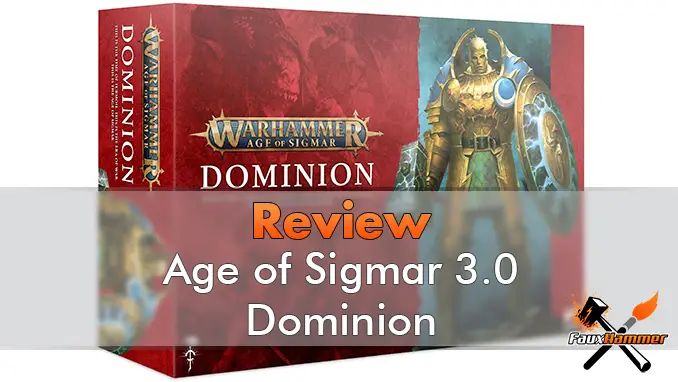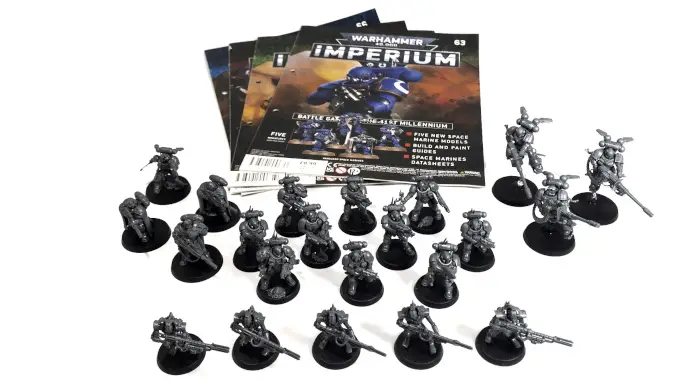One Page Rules: Grimdark Future Review
Wargaming systems can often be dauntingly complex for a new beginner – or even for the seasoned veteran. One Page Rules has billed itself as an alternative and is making waves in the tabletop gaming space with its easy to pick-up rule system and printable miniatures range. Join us as we dip our proverbial toes into the world of One Page Rules’ Grimdark Future and see how it fares against the leviathans it swims upstream against.
Notez s'il vous plaît: This site uses affiliate links. Our Affiliate Partners are shown below
(Affiliate links will result in compensation to the site on qualifying purchases)
Cliquez sur ce lien et achetez vos articles de loisir sur Element Games pour le Royaume-Uni et l'Europe pour soutenir FauxHammer.com - Utilisez le code "FAUX2768" au moment du paiement pour obtenir des points de fidélité doublés.
Nos affiliés / magasins de loisirs
- ROYAUME-UNI: Element Games, L'avant-poste, Jeux Wayland, Mighty Lancer, Goblin Gaming, Planète interdite, Fournitures de décor de modèle, eBay, Amazon
- États-Unis / Canada: MTechCave, GameKastle, eBay (États-Unis), eBay (CA), Amazon
- Allemagne: Taschengelddieb
- L'Europe : eBay (DE), eBay (EN), eBay (ES), eBay (IT), Amazon
- Australie: eBay, Amazon
- Global: RedGrass Games, Couleurs de guerre
- Imprimantes 3D: Phrozen 3D, Élégoo, Anycubique
FauxHammer - Dernière vidéo sur YouTube
One Page Rules: Grimdark Future Review – Summary
As a gaming system, One Page Rules (OPR) absolutely smashes it with a digestible take on tabletop wargames. It forgoes the ‘rules bloat’ many associate with current systems in favour of a streamlined gaming experience, and responds to criticisms levied at games like Warhammer 40,000 by rewriting game mechanics like alternating phases, simplifying list-building and doing away with power-gaming. And it won’t cost you a mountain’s weight in gold for the rulebooks and supplements either.
Where OPR reaches new heights, it stumbles on its originality – but as a continually developing system, OPR has the room and potential to elevate itself to even further heights.
One Page Rules: Grimdark Future Review – Introduction
Out there in the vast darkness of the wargaming void, something has been stirring. And that stirring mass has risen from that darkness – a grim darkness, one could say – in the form of One Page Rules.
Which actually has two pages. And then sixteen in its basic rulebook.
Corny writing aside, what exactly is One Page Rules (OPR) to the uniniaited?
I’m going to let OPR themselves explain their own system for themselves;
Grimdark Future is a single-page miniatures game set in a war-torn sci-fi future, designed to be easy to learn but hard to master. The game is played with 30-40 models per army, giving you big battles that can be played in 60-90 minutes.
Players put together an army and fight over objective points to control the battlefield, using combined arms tactics to win. The game features alternating activations and brutally quick combat, keeping both players engaged at all times.
https://onepagerules.com/portfolio/grimdark-future/
So to put it one way, OPR is intended as an alternative to the bigger wargaming system but in an easily digestible form with simplified rules. It caters to beginners wanting to get into wargaming but find the current crop daunting with the sheer amount of rules to learn, and perhaps moreso to hobby veterans who have difficulty navigating the same game and army rules and yearn for the simpler days of yore. For me, I would add that it favours those who want quick and easy games that can be one and done within the hour – a Warhammer game can take hours or a whole afternoon/evening between two players in the current edition.
In this article, we will be exploring some examples of the exclusive miniatures offered by OPR and a complete game between two armies that was completed within a couple of hours. And it was only 750 points per army to boot – not too shabby for our first time playtesting.
Further on, the article will then naturally invite comparisons to Warhammer 40,000 – the inspiration for OPR: Grimdark Future – and where OPR improves and slips against its much larger cousin. Read on to see our verdict of the miniatures, gameplay and overall place in the hobby – and the ultimate existential question of OPR’s being;
Does it have the potential to replace Warhammer?
Les meilleures imprimantes 3D pour miniatures
Cet article fait partie de notre Meilleures imprimantes 3D pour miniatures Article.

Pour voir la liste complète des imprimantes 3D, consultez cet article.
One Page Rules: Grimdark Future – Contents
This will be a brief section, as there is no box to unbox, and no physical rulebooks to hand either.
All you need to play OPR are the following links to their Google Drive, which has the Basic Rulebook, Core Rules and Quickstart page. You can have them open on a laptop or phone, or print them as handouts at your leisure.
And some miniatures, duh.
Now, the beauty of OPR is that you can proxy any miniatures you have as long as it aligns with base rules. Warhammer, Star Wars: Legion, Bolt Action, Dungeons and Dragons are all game. Even Lego or whatever toy soldiers you had in your youth are acceptable as long as they adhere to the basing rules.
That said, the option for exclusive miniatures is provided by OPR themselves on their storefront. They have a vast array of miniatures on multiple ranges for each variant of their game system, not just Grimdark Future, but also Age of Fantasy. You will notice however that what they offer are STL files for 3D printers rather than physical models – for some, this could be a turn-off, as there is extra expense required to get a 3D printer (or access to one).
Once again, OPR offer an answer to this concern with another storefront where they offer the models pre-printed and readily assembled for a reasonable price. Whichever your preference, it’s worth a browse to see what’s on offer.
The Rulebooks
We might as well start with the most compelling thing (and unique selling point) about OPR, its rules. As the books are downloadable PDFs, please excuse this section if you find it a bit light on pictures.
La Basic Rulebook, despite the game’s name, is actually 16 pages long (15 if you don’t count the title page). The name is a misnomer, as you can’t feasibly have rules for a gaming system that can be localised entirely on one page (unless the text is really vraiment small or you’re Seymour Skinner). Well, maybe it’s possible – but not for the kind of game OPR wants to present.
The benefit to having the core rules as downloadable PDFs is that you can have them open on your phone as opposed to having books taking up table space. For ease, both me and playtester James had both options on the table. We’re a bit old school so needed to have some paper floating around.
The Core Rulebook itself is a joy to read. It’s written in plain and simple English, and goes straight to the point – the rules are written concisely and succinctly without any unnecessary waffle you might find in other game books. There are diagrams throughout that are used purely to demonstrate and visualise a point, for example showing what constitutes line of sight. Some pages have small pieces of art throughout, which are well-drawn if a little cartoonish, but otherwise do not take away from being able to comprehend the rulebook. The 40k core rules, for example, is a heavy coffee table book that is full of rich lore, artwork and photographs of armies, which works as a dual purpose of simultaneously being a rulebook and an encyclopaedia. That doesn’t always work for many – some would prefer a book where they can easily flick between pages to find a rule during a game swiftly rather than having to wade through pages and pages and pages of pretty pictures.
Simply put, the Basic Rulebook has each section clearly marked out so you can easily sift through it and find whatever rules you’re contesting mid-game. OPR’s Google Drive also provides two page Core Rules pamphlet, which you’ll want alongside the Basic Rulebook as well – it’s a cheatsheet designed to specifically define terms in your army rules (more on that soon) and condense the information given in the Basic Rulebook even further so you can pick up the game even quicker.
Quickstart Booklet
Another supplement provided by OPR is the Quickstart Booklet, which is designed to get you playing right this second – almost as if it were a play-through guide. It is nine pages long, most of which are intended to be print-out tokens. The Quickstart Booklet actually provides you with everything you need to play – you don’t even need miniatures, as the booklet gives you the option to print out tokens with pictures of ‘Battle Brothers’ and ‘Orc Marauders’ alongside cards with their statlines. It also provides printable terrain and tokens for a completely 2D game if you so desire – it’s a good way to practice and get a feel for the system before investing time and money into it.
Whether you’re playing with miniatures or not, the tokens are absolutely essential and must be printed out.
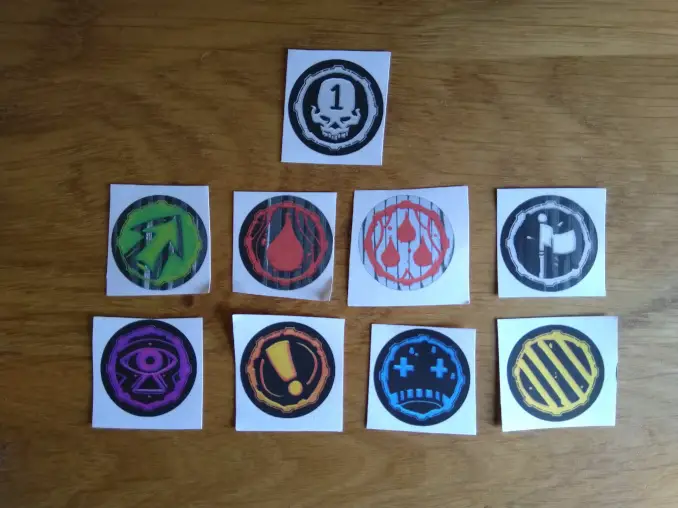
Shoddy job of cutting them out aside, these tokens are very versatile and easy to understand.
From top to bottom/left to right, we have;
- Objective marker (1 to 6)
- Activation marker
- Wound marker
- Wound marker for units of higher toughness
- Morale marker
- Psychic spell effect marker
- 3 other generic condition markers
Now, on that last bullet point, the reason I have termed them ‘generic condition markers’ is because we were not quite sure what exactly they were meant to represent. The Quickstart doesn’t specify either – simply lumping them in the category of ‘Generic/ other effects’. In my opinion, the purpose of these markers (the exclamation mark, the blue face and the grill?) is for you, the player, to decide. The exclamation mark could mean a unit who is on high alert, the blue face could be a unit who is paralysed, and the grill could be for someone who is locked down. Again, these tokens are versatile and could be used (or not at all) at your discretion.
The Army Books
Whatever faction you are choosing to play (or proxy in), you could find your chosen army book from a selection ici. Again, it’s all downloadable PDFs so easy and free to access wherever you are.
The army books tend to be about three pages long. The first page will have a piece of art and some brief lore, whilst the following ones are purely rules and tables for building an army list. Again, I must give kudos to OPR for having all the pertinent information contained so neatly and uniform in a digestible space. The table at the top of page two is the most helpful part, with the rest of the page filled out with options for upgrades, spell rules and other special rules.
This is where I may speak my first critique, and is apparent here in the Saurian Starhost rulepage. The upgrade section felt a bit messy and confusing when we were first trying to find the right weapons of my infantry, and tying it all up together with the overall points cost of the unit. Like in 40K, certain weapon or other loadout options will cost you anywhere from 5 points to 320 points extra. Not knowing what weapon was called what by merely looking at the miniature certainly didn’t help. However, the table does help to mitigate this issue by directing you to the exact lettered section to look for. It was a bit hard on the eyes at first, but once we understood the layout, we were good to go.
Les miniatures
Enough on books, it’s time to talk miniatures, all of which were printed out courtesy of Ross the FauxHammer.com man himself.
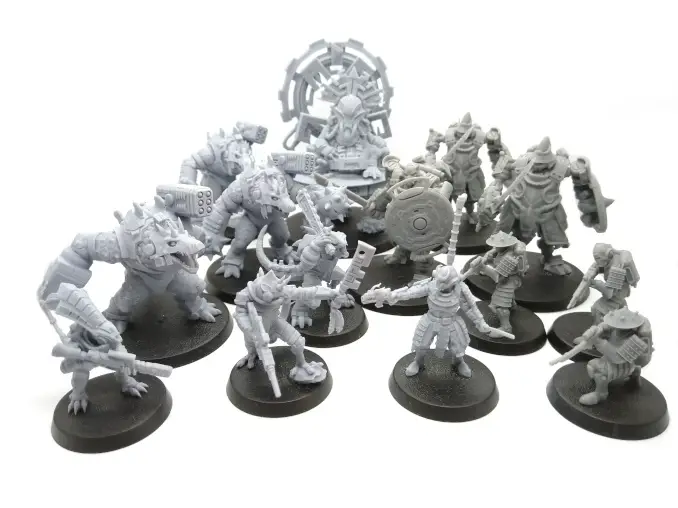
As mentioned in the introduction, you can find what OPR has to offer on their MyMiniFactory storefront. For this review, I chose two of their more distinctive army choices – the Saurian Starhost et le Eternal Dynasty. Lizards with guns, and samurai with guns. What’s not to love?
The Saurian Starhost
To put it mildly, I am a big fan of palaeontology and reptiles. The Saurian Starhost fill those needs in a wargame quite nicely, as they do not have an analogue in Warhammer 40K currently and so make for a fresh choice in a grim sci-fi setting. That said, I won’t deny there is something… familiar about them in another setting, but I’ll leave it there.
Regardless, they are brilliant miniatures to behold. Observe.
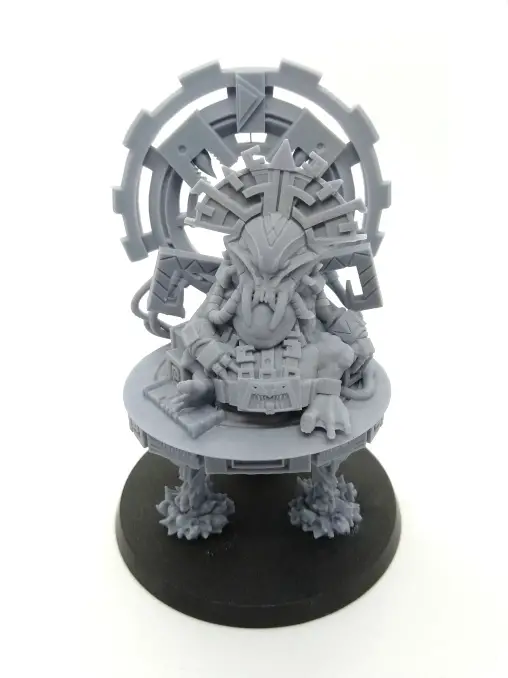
This is my top HQ unit, the Frog Mage. He’s a large, squatting amphibian with Aztec motifs sat upon a floating disc with engine thrusters underneath, held aloft by the smoke they produce. He’s on a 60mm base, being the largest model between both armies presented today. The details are rather crisp, especially on the underside of the cyber-palanquin and on the smoky coils beneath him. It’s not a fragile model at all, and carries presence on the tabletop.
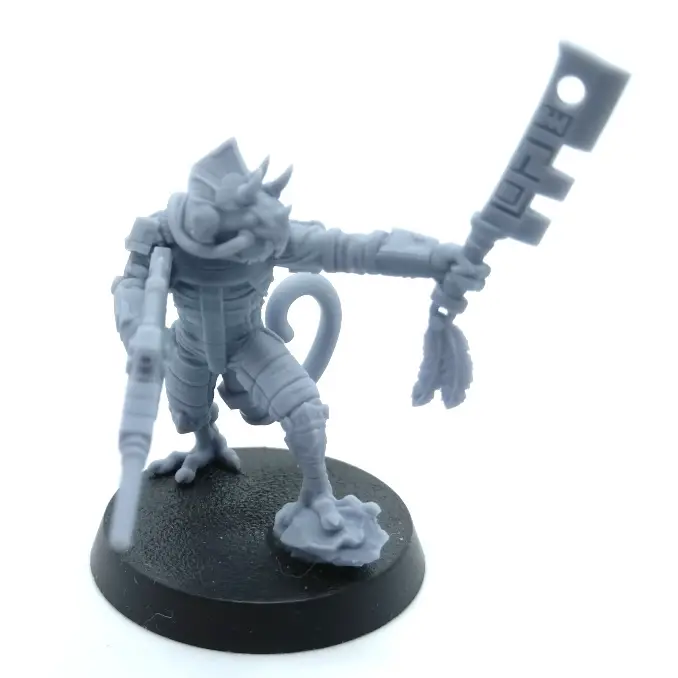
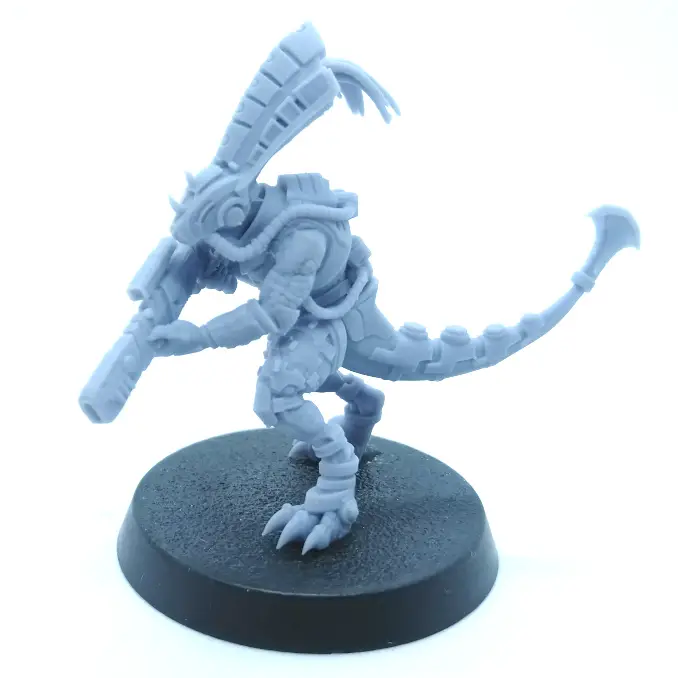
Here are my other HQ choices, the Chameleon Chief and the Gecko Chief – both were proxied as ‘Gecko Champion’ with appropriate upgrades respectively. These miniatures, especially the Chameleon Chief, have a dynamic sense about them. The Chief is quite clearly the chief, standing on his tactical rock with his cleaver blade-thing aloft. To separate them from your typical fantasy fare, these lizards sport detailed space helmets and tubes that go everywhere and nowhere all at once, putting them straight at home with any of your sci-fi themed minis.
I will note quickly the pitfalls of resin, which these miniatures are printed of. It is brittle, especially on thinner parts like the legs. The Gecko Chief got dropped onto a tiled kitchen floor by a bumbling buffoon (me) and became an amputee in the process. It took me 10 minutes to find his missing appendage, and was able to fix it. Still, I broke a few miniatures when removing the support stems. Though 3D printed miniatures often forgo assembly, and thus there are no mould lines or sprue gates to clean up, the support stems can be a drawback and so be cautious when removing them from fragile areas of the model. Furthermore, there is still clean up required – there may still be little rods lingering on the models that need to be filed down.
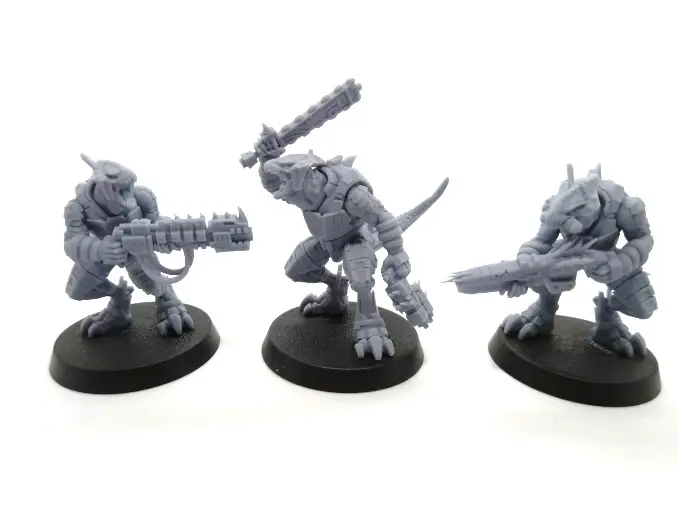
As we move onto infantry, you’ll notice how each Saurian Warrior is unique in their loadout, poses and level of detail, despite being in the same unit. Again, this is a testament to the amount of detail an STL file can produce into a miniature.
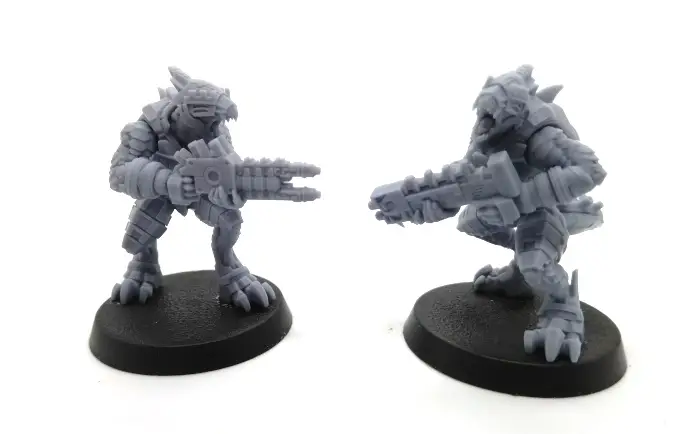
Each warrior had a different gun, and so when building my army list, I had to expend a lot of points to reflect their models. I didn’t really know what was meant to be what, so I just resorted to educated guesses. These miniatures are still fantastic all the same.
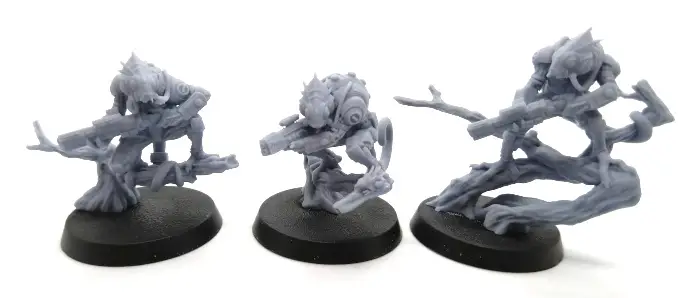
Shock infantry came in the form of five chameleons, which outdo the Saurian Warriors with their design. Putting them on tree branches was simply genius, as it allowed even more dynamic potential with the poses, showing the model interacting with their environment. Of course, they do look a little strange when you move them inside buildings.
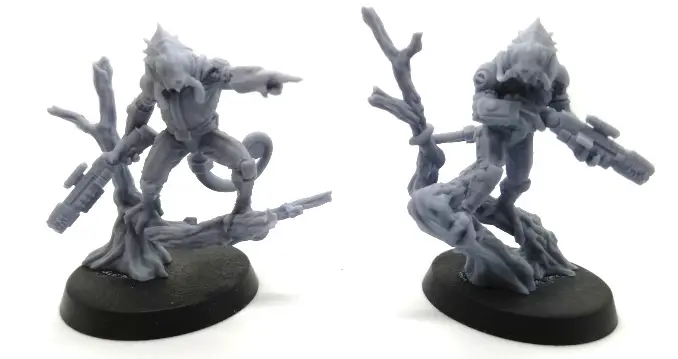
These particular two are my favourite. Again, they really delve into the reptile theme, as well as envision their Stealth rules with the models.
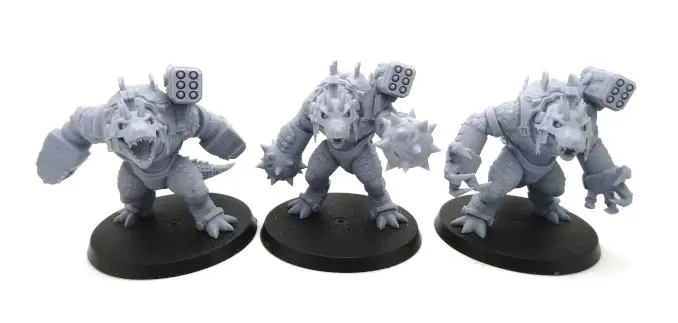
I saved the best for last. These imaginatively named Gators are the best of the bunch, they fill that Elite/ Heavy Support role you’ll need for your army of scaly space monsters. This is all I wanted in roided up reptiles, and then some. They all have missile pods strapped to their shoulders, one has mace hands and the other gun hands. They look absolutely formidable on the tabletop. The scale details are impeccable, the teeth finely sculpted and the osteoderms (bony plates) sublime. They are the Pillar Men of crocodiles, and I’m all for it.
The Eternal Dynasty
The Eternal Dynasty are another faction I picked because they are not directly derivative of another army, other than historical Japanese samurai/ feudal armies. Not just that, I love the Japanese aesthetic, and how OPR build on that to create something new for the grimdark universe. I’m more excited to paint these up than the Saurians, to be honest.
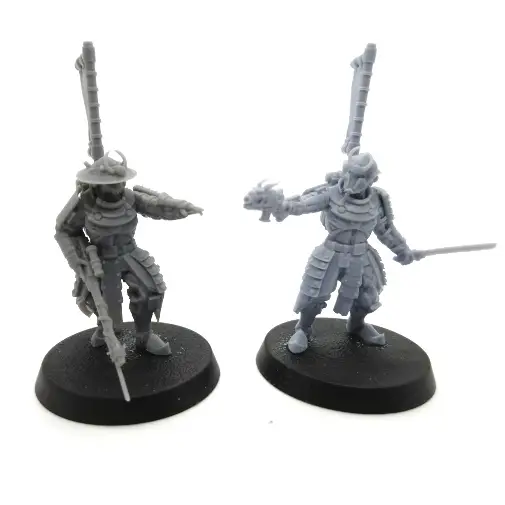
These are Dynasty Captains that we proxied as Dynasty Leaders, a HQ choice for the Eternal Dynasty. They are excellent in that, like some other HQ choices, can assimilate themselves into an infantry unit in a way that mirrors the Character rule in 40K – the infantry models must be targeted first if these guys are at the back of the line of sight (although anything with the Sniper rule can forgo this). From a design point of view, these are another fantastic set – each armour plate is sculpted cleanly, and the one on the right has a very detailed pistol with dragon motifs, as well as a Mandalorian-esque helmet. The one on the left has a skull-like alien face shadowed under his large hat, just to make it clear that these are not human.
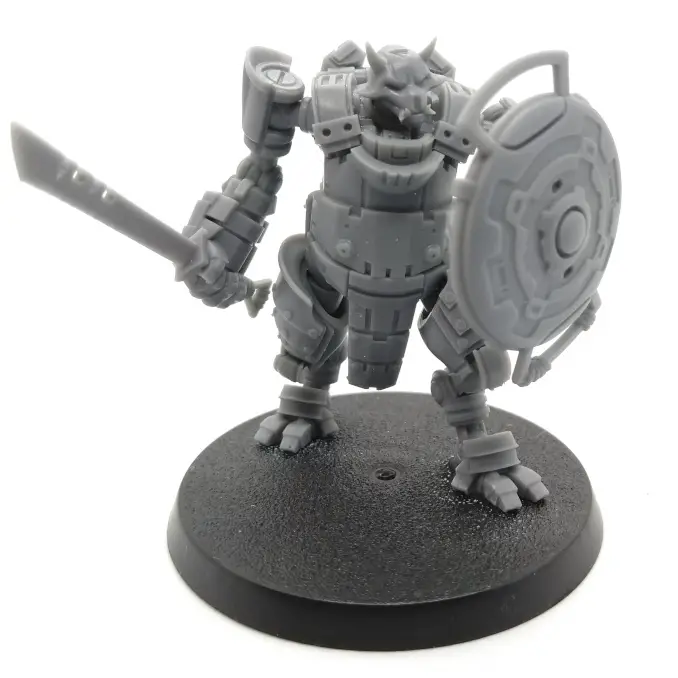
The other HQ choice is this ONI Captain. From what I understand, this is a robot, rather than a mechanised suit of armour as I first suspected. Nonetheless, this is one of my favourite sculpts of the OPR bunch – the oni helmet is an inspired choice. The notches on the shield and the sword are a nice touch.
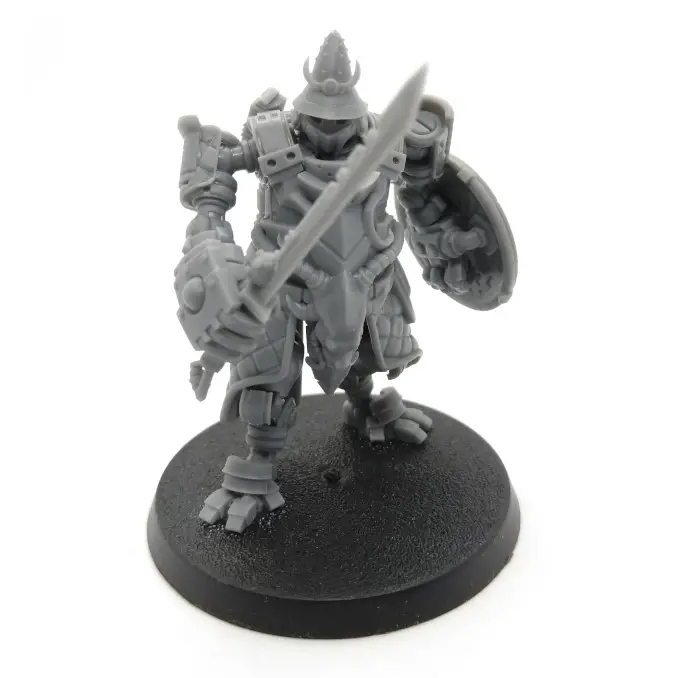
Following up, we have an ONI – a subordinate to the ONI Captain no doubt, so the sculpt is similar but very different at the same time. The armour carries a dragon motif and the helmet is samurai-inspired. There’s something about his eyes that seem friendly in that Baymax way, but the ONI brandishing his sword makes me think otherwise.
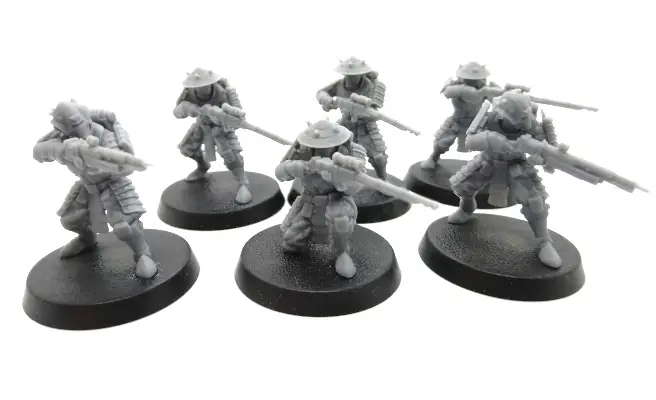
The final models are these Dynasty Warriors, the rank and file infantry squads for the Eternal Dynasty. Their poses, though basically the same, are still rather dynamic and very fitting for hardline troops. There is variety with helmets to make them pop. Though basic, they still possess a high level of detail.
Due to the resin material they are made of, the barrels of the long rifles are pliable and have bent slightly. I imagine this can be solved with the hot water method to reshape them back into place.
Now, whilst I have high praise for the miniatures, they are not at the same level as Games Workshop :. The details are great, but GW produces details that are so intricate that people speculate and obsess over them – this was especially apparent with the recently released Angron, Daemon Primarch of the World Eaters. He is covered in skulls, but because one had a cybernetic eye, people were adamant that this must belong to the recently deceased (?) Commissar Yarrick, and then speculation fuelled that he must have been offed by Angron. These are the kind of design considerations that GW love to incorporate into their work, and it’s all part of the fun.
It’s not just about the details, but also the poses – look at some of the recent Cadian troops carrying big plasma guns, their body posture is hunched over slightly and it gives a real sense of weight that the miniature is grappling with. In comparison, the OPR miniature fall back on some pretty basic poses, that work, but could be improved with more dynamism. The ONIs are just holding their sword defensively, and standing there rather woodenly. The Dynasty Warriors kneeling or standing with their guns aimed work for what they’re doing, but the sense of action is a bit stilted and could do with greater variety.
That’s not to say that OPR couldn’t improve with their sculpts and poses – they are releasing stuff all the time, so whose to say they couldn’t evolve over time? At the end of the day, as it currently stands, they could do with that je nais se quois that GW miniatures excel at and pump out on the regular.
One Page Rules: Grimdark Future Review – Gameplay
It’s time to talk about what people are probably most interested in – how does OPR play? Is it 40K without the rules bloat and Codex creep?
We’ll get to that in due course, and explore that question along the way as we do an actual play-through of OPR: Grimdark Future.
Set-Up
To be honest, the set-up part is barely different from a regular Warhammer game. You’ll need a surface and some terrain first. OPR recommend a flat 6’x4′ surface like a table – though the Basic Rulebook also gives you the option of playing on the floor or the bed, much to your missus’ delight.
With terrain, they recommend you place enough blocking pieces so you can’t draw a clear line of sight edge to edge, and a variety of cover that can be classified as low cover, high cover, difficult and dangerous terrain. They’re also happy for you to proxy household items in lieu of actual terrain pieces.
I, however, was not content with using Pringles Can Tower or Magazine Stack Bunker for terrain. I went and bought some bits from Battlefield in a Box and was ready to go.
This was our battlefield for the afternoon.
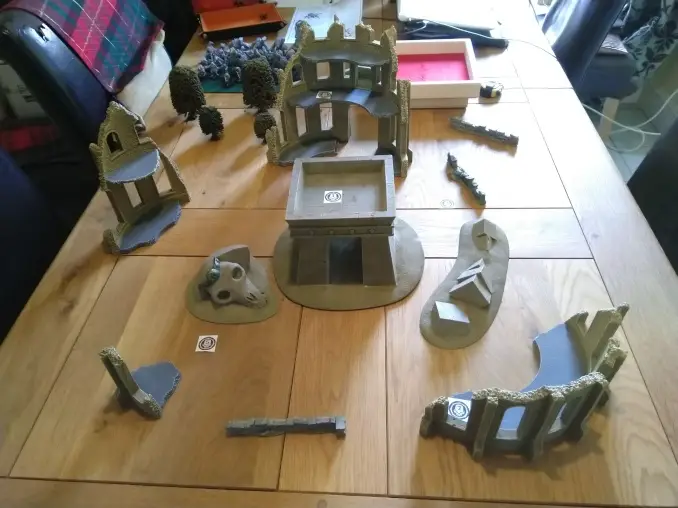
We built our army lists in preparation the day before, and decided on 750 point armies, as OPR recommends as a starter game.
The next step was to mutually decide where the five objectives would be, so we spaced them apart whilst giving both players advantage on either side to claim one on the first turn. We then rolled off to see who would go first. I won like the dice-rolling pro that I am, and so deployment begun!
Now, this is where OPR deviates from Ninth Edition 40K. We deployed units in turns – as in, I put one unit on the field first, and then my opponent James placed one of his down. This is a system I recalled existed in a previous edition of 40K, but I cannot remember which one. This way, neither player could be strategically influenced by each other’s deployment method.
This is what my deployed army looked like;
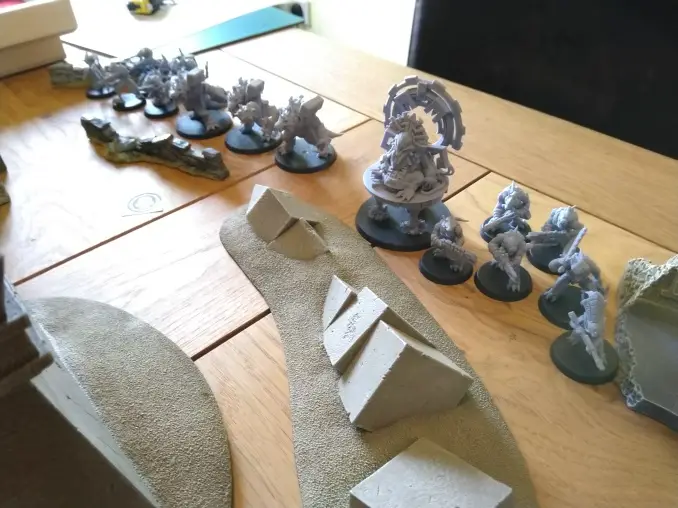
Not a lot, is it? Compare that to James’ deployed army;
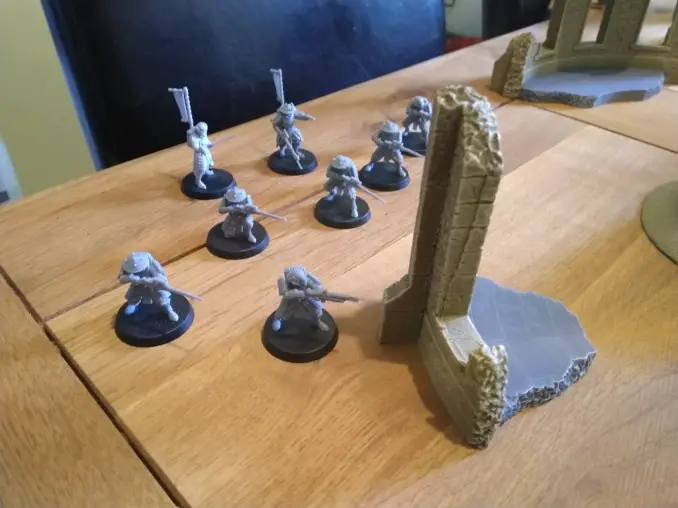
750 points, you think? To be fair, the units are quite expensive in points (especially with each individual weapon upgrade), and all four of his ONIs were off the board in reserve (Deep Strike in 40K terms). Does seem a bit unbalanced at first, but we’ll have to see as the battle goes along.
Round One
As I won the roll-off, I made the first move of the whole game. I moved the Gecko Chief 6 inches to his left, claiming the first objective marker. This is called an Advance.
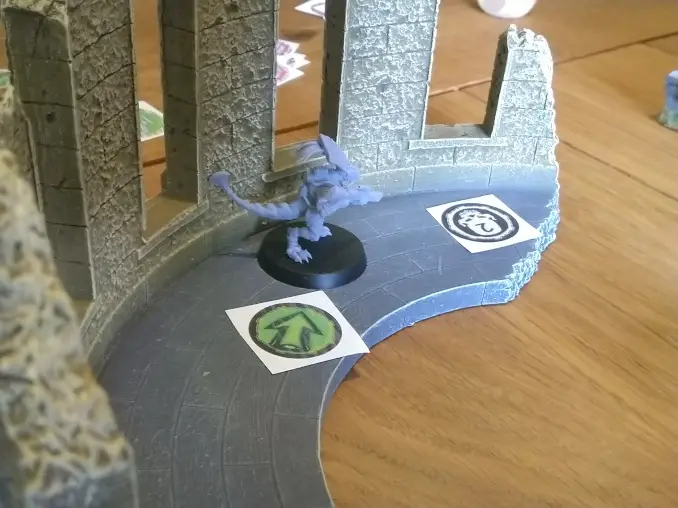
6 inches is the standard movement any unit can make. Now, from here I had many options. I can hold my action after advancing, which would enable me to shoot next. I can move another 6 inches (making it 12) to Rush, but that would prevent me from shooting. If there are any enemy models within 12 inches, I can Charge to move into melee.
Sounds familiar and pretty basic, right? Except this is where we deviate from systems like 40K. Instead of selecting another unit or model to move, I can now shoot with the Gecko Chief after holding my action. There are no movement or shooting phases – only activations. Speaking of activations, you must take an activation token (green arrow) and put it next to your unit/model, to show it has been a busy boy.
The Gecko Chief has a sniper rifle, and James’ Dynasty Warriors are right in my line of sight – so I took a pop at them. On my army sheet, the Gecko Chief has a ‘Quality’ of 5+ – so I can only hit on a 5+. I failed the roll, and that was that – but even if I had succeeded, there would have been no rolls to wound like you would in Warhammer; instead, your opponent must roll against your successes, skipping the wound rolling entirely. For each fail they get against their defence stat, it counts as a wound – and they must take the damage accordingly.
We found that all our regular infantry had one wound to each model, and so a single activation could be absolutely brutal if the attacker was able to score multiple hits. Tougher models like the Frog Mage and the ONIs will have a special rule called Tough and then a number beside it (i.e. 3) to indicate how many wounds it can take. Even the beefier models could be wiped out in one activation, if not careful. This may be part of why OPR games are intended to be quick – units die easier!
As the Gecko Chief failed to do anything, it was done. I don’t move onto another model like you would in Warhammer, instead it’s my opponent’s turn to fight back.
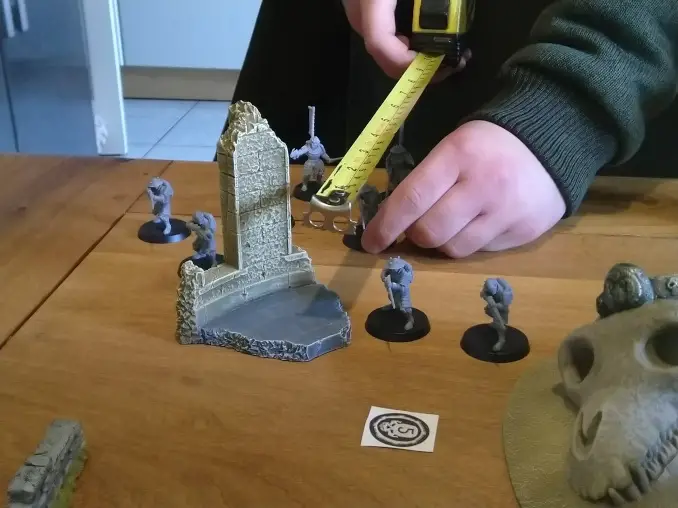
Taking advantage of the cover rules, James pushed his warriors forward with the Dynasty Leaders at the back. He hid some of them behind the ruin, meaning I got -1 to hit rolls against them in future rounds. His Leaders (quite cowardly) hid behind their troops to try and force me to target the infantry first. With my Chief’s sniper, I could target them regardless – but any other weapon could not. Instead of rushing them further forward, he chose to keep them there, as his rifles had 30″ on me – and the Chief was well within range.
After holding action, he started blasting and got me with his superior numbers. Luckily, my Chief has Tough 3 so he only lost a single wound out of 3, as he rolled terribly. Karma for his dishonourable ways, no doubt.
After that, we moved back to me and I moved my unit of Saurian warriors.
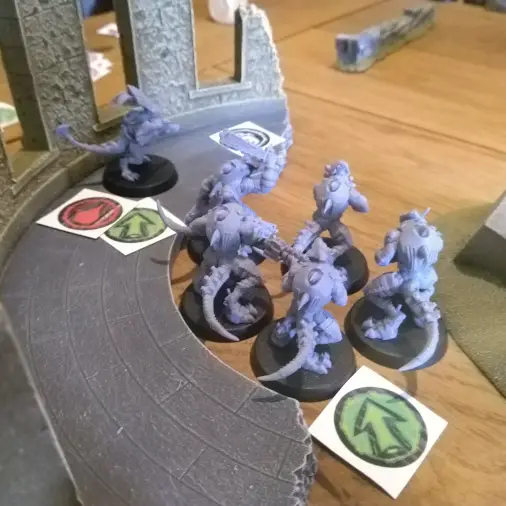
As you can see, since my Gecko Chief took damage, I put a wound taken by his base. The warriors waddled around with their five different guns and I left them there, to deny James the opportunity to shoot them first in his next turn.
Since James had only one unit on the battlefield – his ONIs could only deploy in the next round – I could do all my other activations next. This did put him at disadvantage with his army list, as it would give me more opportunities to claim objectives or take pot shots at his only unit on the table were I close enough, so something to take note when making lists of your own.
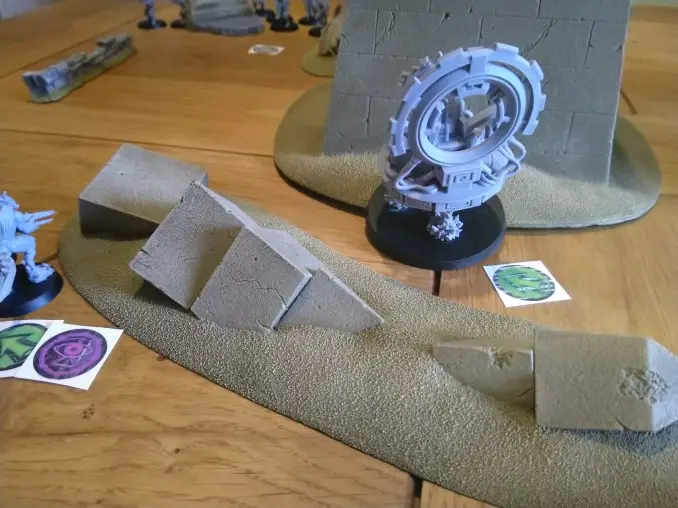
Next up, the Frog Mage decided to go hippity-hoppity over this sunken ruin in a sand dune we had declared as Dangerous Terrain. To traverse Danger Terrain, you roll a dice – if you lose against your Defence stat (2+ in my case), then you take a wound. That’s insta-death if you’re weak as hell, but with a Tough 3, the Frog Mage was safe, had he failed. I did not.
Being out of range of my psychic spell attacks (the Frog Mage is classified as Psychic, meaning he can conjure spells – just like 40K’s Psychic phase), the Frog Mage instead cast Transcend on the warriors – he succeeds on a 6+, so you need to roll a single D6 and then add the modifier in the table (i.e. Psychic [2]). Since I succeeded, I put a spell token down on the warriors, meaning they get to regenerate the next time they take wounds.
After that, I moved Gators and Chameleons forward and claimed another objective. And that was the whole round.
Now, long did that whole shebang take? About 20 minutes approximately, seeing that we were still learning the game and grappling each other about rules. But that could have been done in much less time for the experienced gamer.
But being the first round, there would be no close combat, as everyone was still far away from each other. That would change shortly.
We counted what objectives we claimed and put the Morale token next to each one claimed, to denote what was ours. I had two, and he had one. Time for Round 2.
2ème round
Now you, the reader, has had a taste of how a round goes, we will speed through the game and highlight the interesting parts that happened here on out.
Since I was the player who had the last activation, James would get to go first. And of course, the first thing he does is get his ONIs out of reserve and plop them straight onto an objective.
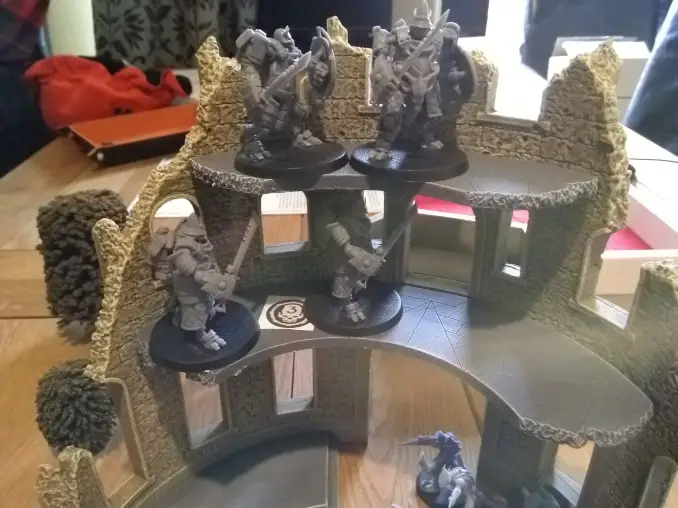
The ONIs have jetpacks, thus they get to fly and Ambush. Ain’t that crazy.
If we both have had units with the Ambush rule, then we would have had roll off who got to Ambush first, regardless of who activated last.
But he doesn’t waste any time and charges them immediately into my Gators, who were holding an objective. Unlike in Warhammer, you don’t roll to charge – you just do, if you haven’t held your action, or shot (though you have to be within 12 inches). Any models within 2″ of enemy models can just unload any melee attacks they have like their name was Kenshiro and absolutely hammer their targets. Because that was what exactly happened to me.
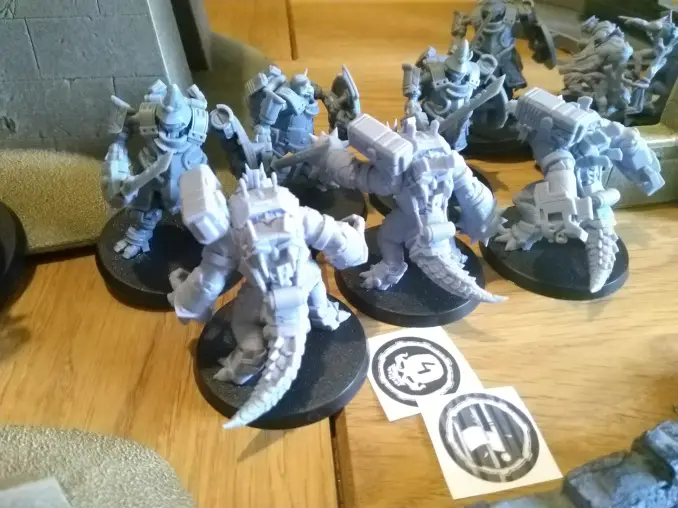
The ONIs have a basic melee attack called Bash, and with 2 attacks each, the Gators were about to get turned into shoes and handbags. I had to roll 5 saves, and with 3+ Defence, I succeeded the first barrage. Then he hit me with his swords, and I got 3 fails. One Gator got skewered on the spot, despite having Tough 3. He attacks, this time with the ONI Captain, and devastates me with a further 2 wounds.
Despite the battering, I have two Gators firmly planted on the objective, almost dead but still breathing. He can’t take it until he’s got more models piled on it than me.
Now, like in the Combat Phase of 40K, I get to hit back. If I choose not to, the unit becomes fatigued, where they can only hit on 6+ until the end of the round after they strike back. I was keen to take advantage before they die and try my luck, but his shields subtract 1 from my hits. The Gators missed.
Both units are considered fatigued, and I have to take a Morale test as I lost models. I rolled a single dice (and added 1+ to my score because of the Fearless trait). With a 5, I passed, so the Gators stayed. Like Morale or Battleshock in Warhammer, you could lose your entire unit on a bad roll. Afterward, the ONIs get pushed back a single inch.
Our next activations go to my warriors and his respectively, who pew pew each other. Nothing too flashy there, other than the Saurians just flat out walk into a massacre.
The Frog Mage makes it to the top of the middle objective and claims it, whilst my Chameleons sneak in and take the objective left by the ONIs. It should be noted that here, once you have claimed an objective, it is yours until the opponent claims it, even if you leave the objective. This feature sings to me, so I’m not forced to spread my army thin and leave them like sitting ducks just to hold objectives.
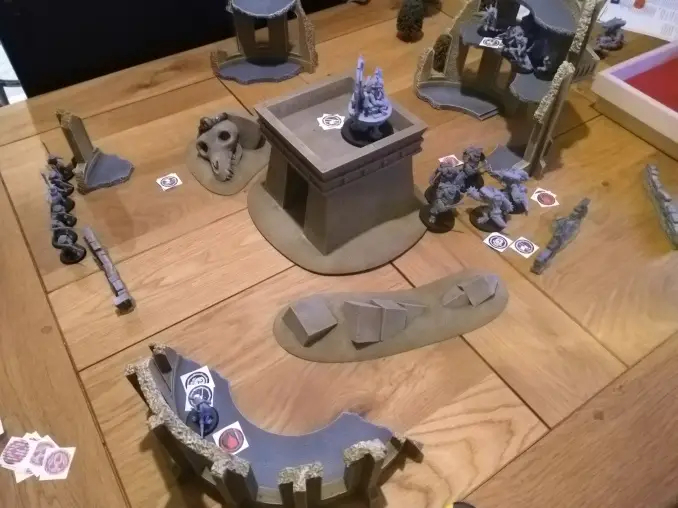
At the end of this round, I still have the stranglehold on objectives, owning 3. This would change in the next one far too swiftly.
3e tour
We’re nearing the end, but it has been quite a ride. James is about to flip the tables on me like a money changer in a temple.
In what one would call a ‘pro gamer move’, he pulled his ONIs out of the croc melee and jumped behind my Frog Mage, who at this point had also been casting ‘Serpent Egg’ on them, killing one. I like to think he was literally pelting them with snake eggs.
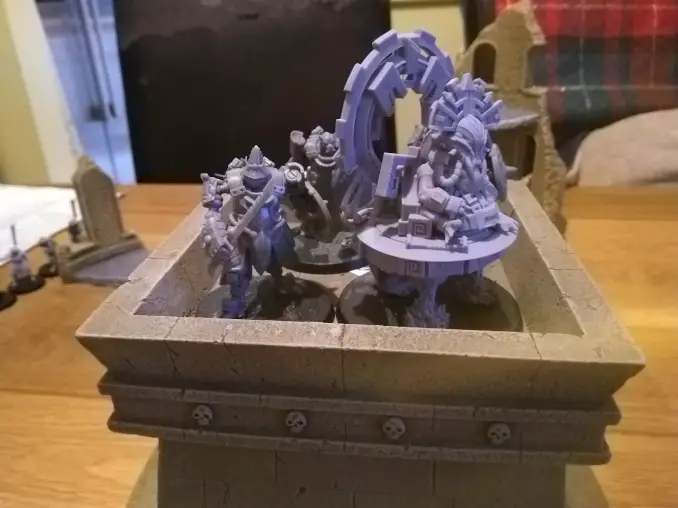
Of course, you can gather what happened next. Despite his Toughness of 3, the Frog Mage is still a big squishy frog after all, and folded immediately from a barrage of Bashing and sword strikes. He was too good for this world.
Envigored by the loss of their great leader, the Gators struck back and fired missiles on the ONIs. Because the missiles gave them the ability of ‘Lock On’, I got to ignore any negative modifiers to my rolls, like his Shield Wall. I even got an unmodified 6 – with the Predator trait, I was granted an extra attack. It wasn’t much, but it was enough to destroy another ONI. I’ll take any licks I can get.
Things took a turn right around here. With the loss of Big Frog and the warriors, the Dynasty Warriors took an objective from me after killing the Gecko Chief.
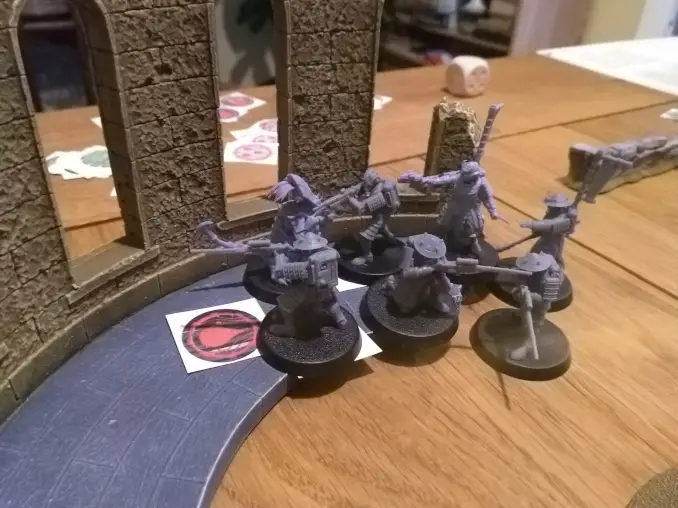
On the other side, my Chameleons were able to poison an ONI, despite being a robot. It yet lives, and the round is over. James now controls three objectives, and I just two. Oof.
Round 4
This would be the final round, the one to uplift the winner and cast the loser asunder. My chances were slim, but I won’t go down in vain.
After the melodramatics were over, the ONIs charged encore into the Gators, having decided they hadn’t been punished enough. This becomes the shortest round as a result.
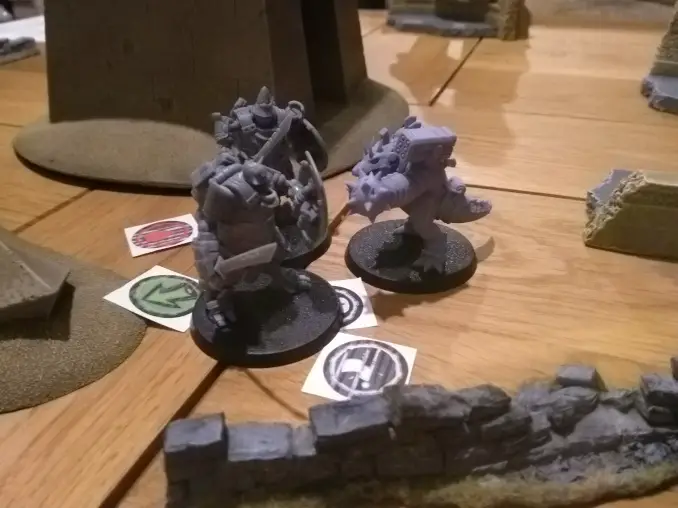
After croc bites the dust, and the last one left standing takes a beating so hard he nopes out of reality – that’s me failing the morale test. RIP in peace.
All I have left are my Chameleons, who are holding onto the final objective. The Chameleons shoot into the remaining ONIs, but do nothing of consequence. The Dynasty Warriors, however, move up the board and fire all cylinders at the Chameleons, absolutely rolling into them, taking five out, even with their Stealth bonus, which gave James -1 on all his hits.
The Chameleon Chief manages to survive and holds the objective, leaving me only one point for the entire game.
And it’s all over. Look at the carnage.
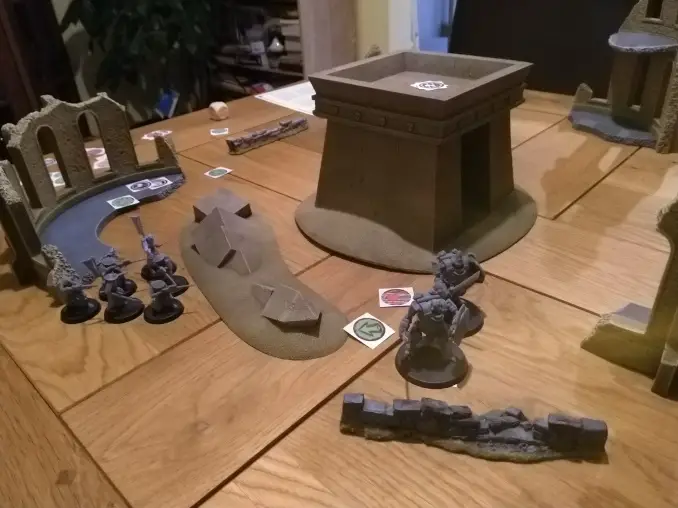
Or lack thereof, as I have basically nothing left on the board!
Regardless of James’ overwhelming win, we both enjoyed our game, and the fact that it took just under 2 hours to complete. Though the game was a loss for me, it was a win for my heart.
One Page Rules: Grimdark Future vs Warhammer 40K
So we’ve just gone through an entire game of OPR: Grimdark Future, what are our thoughts?
The fact that we did the entire game within a couple hours was mind-boggling to us. Both me and James are notoriously slow players, carefully considering every move and mistake we make – and that often brings games to a standstill whilst we squabble over rules and moves. The next time we play, we know we will be going considerably quicker – as we get the system now.
And that alone gives the system a massive plus over Warhammer games. I’d like to note quickly that I am not here to slam and shame Warhammer – a game that I still love despite some contentions I’ve had with Ninth Edition – but I am here to compare these two systems, and where one works where the other doesn’t.
I’ve spoken of a speedy game between the two of us, and that is primarily due to the easy to pick-up rules which were generally equal across the board. The Dynasty Warriors and the Saurian Warriors all had the same movement and weapon upgrades that packed a punch when shooting and fighting in close combat. The fights between the bigger elite units that went back and forth could have gone either way – neither side had any disproportionate advantages over the other. It was the dice deciding the fates of the models rather than Gotcha! moments.
A big part of the game speed was the alternating activation system, where players took turns in playing their units, as opposed to having to wait an entire turn for their opponent to go through six entire phases before you get to touch your army, and then potentially be absolutely tabled the first round. Previous editions of 40K did something similar (feel free to correct me if I’m wrong, I have fuzzy memories of entering the hobby at fourth edition), but this is not how it is in the current game. Me and James both commented how much more engaging it was alternating units – we weren’t sitting there waiting for one another to hmmm and hawww over whether it was time to deep strike 50 T’au battlesuits into your foe’s battleline while hitting the griddy on that squad that someone spent a lot of hours painfully painting and putting together. There was less chance of either side doing a bit of power-gaming too – as units went through their activations pretty quickly, you had to think on your feet and react more than try to strategise and min to the max.
Speaking of power-gaming, the lack of ancillary things like stratagems really streamlined our experience. Stratagems are a recent addition to the Warhammer universe, in both 40K (9E) and Age of Sigmar (though called Battle Tactics there), and have seen a mixed response from the community. The fact that a faction can have up to 40 stratagems, including the universal ones, is a bit nutty – it’s great for those who can memorise and utilise them efficiently like a wargaming Rain Man, but others will find them as, at the worse case, more baggage weighing down the playing experience. I am in the latter category – I use Datacards to try and remember every Synaptic imperative my Tyranids can do, but then I also have to account for my opponent’s stratagems too. Games Workshop : have been slimming down Command Points in recent updates of the game, so they are at least reacting to this kind of criticism. At times, the stratagems really felt like Gotcha! moments set to annoy the opponent rather than improve the gameplay.
OPR having no such things really lightened the experience for us, and it felt like an even playing field between us. There were definitely still tense moments where the outcome could not be determined so easily, and it felt like a fresh facelift for us. We weren’t obligated to finish a game just because we started one, we wanted to finish because we were never 100% on who would take the crown. For the first two rounds, I was winning, but then in the next, I was being overtaken. No one was being absolutely steamrolled in the first or second turn, and that’s how it should be.
Now, this does ask the question, what exactly is OPR’s identity as a game? That it’s a simple version of Warhammer? For all the faults one can find with Warhammer, it has an established identity as a gaming system that only has inevitably bloated due to its age and ever-expanding MO. Stratagems were a way of mixing things up for 9th, as they do give each individual army more options and flavour for narrative sake and competition. This flavour, also contributed to with faction-specific rules and benefits, helps shape 40K’s identity as an epic narrative game. It attracts players to certain factions within factions – I mean, look at all the Space Marine legions with unique HQ choices and unit upgrades and traits – and influences how they want to model their army. You want big brain bugs? Go for a Tyranid force with hard-hitting psychic elites like Maleceptors and Zoanthropes. How about the classic horde mode? Spam gaunts and genestealers, and then a Tervigon to spam even more gaunts. On the flipside, this can drive things too far into the meta territory when a new Codex rears its head – and not all armies are made equal. Many players are sick of the Codex creep too.
Regardless, I would not want to say one system is better over the other, but I will say they will benefit different types of players. OPR is perfect for casual gaming, whilst 40K floats between casual and super serious.
One Page Rules: Grimdark Future Review – Price and Availability
This will be a short section, and my treat for those who have made down this far. Essentially, the Core Rules, Army rules and additional supplements are all free and can be downloaded ici et ici.
Any cost you may incur will be getting models. You can easily substitute your own, and pay no further cost. If you want the OPR specific miniatures, you can visit their MyMiniFactory page and have a browse. Here, the expense lies in the 3D printing side – if you have a 3D printer, then you’ll find the army bundles actually rather cheap and good for value. As an example, this Saurian Starhost bundle will set you back $78 USD for the STL files but provide you with 65 miniatures. That’s an instant army ready for the table (after cleaning and painting, of course).
As an alternative, and as you’ll soon see, the obviously preferred method of model acquisition is to Join One Page RulesPatreon page. As a Tier 2 patron for only £10 a month, you’ll be rewarded with all their latest releases which is up to 80 or so models and growing – this varies depending on the scale of the models. You also get an immediate 50% off their MyMiniFactory page mentioned above. This occasionally jumps to 70% to celebrate certain milestones. Along with the latest models, normally themed around 1-3 specific armies dependant on the flavour of the month. You also get loyalty rewards for the length of your term. Some of these are truly epic models which dwarf some of the larger Forge World units! There’s even more too for the gamers – you get additional missions, point calculators, rulebooks, standees and more. So if you yourself have, or know someone with access to a 3D printer, this is certainly the way to go. Imagine getting all of games Workshop’s latest releases every month for only £10 a month! This is the closest thing to that!
Lastly, OPR have some of their models printed for purchase on Only-Games if you’d prefer. I cannot calculate the cost for you there – because it depends on what you’re looking for! But they will inevitably cost more than the STL files, so be warned.
One Page Rules: Grimdark Future Review – Final Thoughts
| Pour | Contre |
| Very easy and digestible rule system Can be played quickly Rules make both sides feel more equal Great alternative to bigger systems Free books supported with digital updates Can proxy your own miniatures in Has some unique factions (or takes on existing ones) | If you want the OPR miniatures, you’ll want access to a 3D printer to build an army Resin miniatures have problems associated with resin Has derivative elements Army list building a bit muddling on first try |
From the gaming side, I’d be lying if I didn’t say that OPR has won me over. The fluidity of the game has enamoured me, simply by stripping back the fat and returning to monke the basics is such a refreshing thing in a time where some of our old favourites have become too convoluted to be enjoyed at their fullest. We simple folk yearn for simpler times – and OPR descends from the heavens on the backs of angels with the answer.
That’s not to say we should disregard any other gaming systems in the same space at all – OPR can co-exist with any of them. It’s made for beginners and veterans alike, those who want to play without being buried by rules and scripture on a biblical scale, and those who want to dip their toes in these waters with inflatable armbands.
What I would want from OPR: Grimdark Future, however, is to go forth from here, diverge and create that unique identity for itself. Make epic lore that isn’t derivative. Make more of what we see from the Eternal Dynasty – a faction with no comparative 40K analogue, but with brilliantly inspired models. With a massive webstore of STL files, perhaps OPR could one day branch out to make physical miniatures en masse and make an even bigger wave on the miniature wargaming market.
Ultimately, the game should come down to whether it’s fun or not…
Yes, it is.
If you like your games to be fast-paced and heart-racing, then OPR: Grimdark Future is for you. There’s no simpler way to end this review – you don’t even need the special miniatures. Just get out what you have, grab another unwitting victim and start building your list.
Notez s'il vous plaît: This site uses affiliate links. Our Affiliate Partners are shown below
(Affiliate links will result in compensation to the site on qualifying purchases)
Cliquez sur ce lien et achetez vos articles de loisir sur Element Games pour le Royaume-Uni et l'Europe pour soutenir FauxHammer.com - Utilisez le code "FAUX2768" au moment du paiement pour obtenir des points de fidélité doublés.
Nos affiliés / magasins de loisirs
- ROYAUME-UNI: Element Games, L'avant-poste, Jeux Wayland, Mighty Lancer, Goblin Gaming, Planète interdite, Fournitures de décor de modèle, eBay, Amazon
- États-Unis / Canada: MTechCave, GameKastle, eBay (États-Unis), eBay (CA), Amazon
- Allemagne: Taschengelddieb
- L'Europe : eBay (DE), eBay (EN), eBay (ES), eBay (IT), Amazon
- Australie: eBay, Amazon
- Global: RedGrass Games, Couleurs de guerre
- Imprimantes 3D: Phrozen 3D, Élégoo, Anycubique
FauxHammer - Dernière vidéo sur YouTube
Qu'as-tu pensé de ça La revue? veuillez nous le faire savoir dans les commentaires.
Si vous aimez ce que nous faisons ici, vous pourriez vraiment aider à encourager plus de contenu avec un partage sur n'importe quelle plate-forme de médias sociaux.
Cliquez sur les liens de partage en bas de cet écran (ou sur la gauche pour les ordinateurs et les tablettes)
Voulez-vous rester à jour avec le site? Vous pouvez vous abonner dans la barre latérale pour RSS ou par email ci-dessous
(La barre latérale se trouve sous l'article sur les appareils mobiles)










